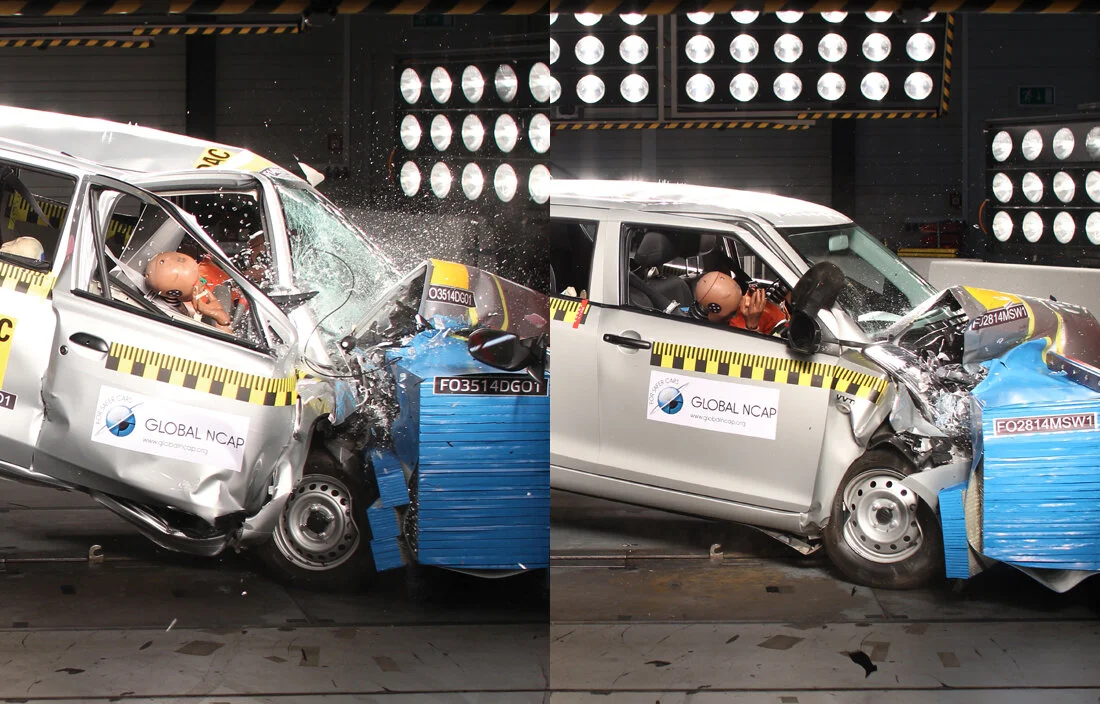IIHS Status Report: Tests Show How Cars Sold In India Fall Short On Safety
Nissan’s Datsun Go couldn’t be sold in North America or Europe. Neither could the Maruti Suzuki Swift nor a host of other new cars produced for consumers in India. Not only do these models fail to meet stringent U.S. and EU safety rules, they also fall far short of the United Nations’ minimum crash-test standards.
New test results from the Global New Car Assessment Programme (NCAP) show how manufacturers can sell substandard models in emerging markets — and it’s all perfectly legal. That’s because India’s government doesn’t yet require vehicles to meet U.N. regulations for occupant protection in frontal crashes and side impacts.
Highlighting safety deficiencies in cars sold in India and other fast-growing automotive markets is part of Global NCAP’s mission to create safety marketplaces in these countries. The London-based organization offers technical guidance and financial support to expanding new car assessment programs as part of the U.N.’s Decade of Action for Road Safety, a program to halve the death and injury toll on roads worldwide by 2020 (see “Safety gains aren’t global,” June 27, 2013). IIHS is among Global NCAP’s associate members.
NCAPs launched in Latin America in 2010 and Southeast Asia in 2012 are having a positive impact on vehicle safety in these regions. In India, plans are under way for an NCAP to provide Indian consumers with vehicle safety ratings. Until that program is up and running, crash tests are being conducted by Global NCAP, which has urged New Delhi to require all new cars to have airbags and a strong occupant compartment.
The Datsun Go and Suzuki Swift are the latest popular model small cars to be evaluated in the Safer Cars for India project. Both hatchbacks lack airbags and received Global NCAP’s lowest rating of zero stars (out of a possible five) for occupant protection in an offset frontal crash at 40 mph — a test that nearly all models in North America, Europe, Japan and Australia ace. Injury measures taken from driver dummies in both tests indicate high risk of life-threatening injuries.
The Datsun Go “has a body structure so weak that it is pointless to fit an airbag,” Global NCAP Secretary-General David Ward said in announcing the results in early November. “It is disappointing to see a global company like Nissan launch a new car design in 2014 that so clearly falls below U.N. safety standards.”
Global NCAP Chairman Max Mosley called on Nissan to withdraw the Datsun Go from India and other markets and redesign it. The Go’s structure collapsed in the crash test, and the driver dummy’s head contacted the steering wheel and dashboard.
“Nissan engineers know how to build safe cars,” says Adrian Lund, IIHS president. “Three of their 2014 models sold in the U.S. earn the 2014 IIHS TOP SAFETY PICK+ award when equipped with optional front crash prevention systems, and another is a TOP SAFETY PICK.” (See list of winners)
Earlier this year, Volkswagen agreed to equip its entry-level Polo model with standard driver and front passenger airbags for the Indian market, a move Lund applauds.
In an initial Global NCAP test, a version of the Polo without airbags received a zero-star rating. The Polo, unlike the Go or the Swift, has a decent body structure, so in a test of the airbag-equipped Polo, the rating improved to four stars for adult occupant protection.
This article was published by IIHS in its Status Report research publication





